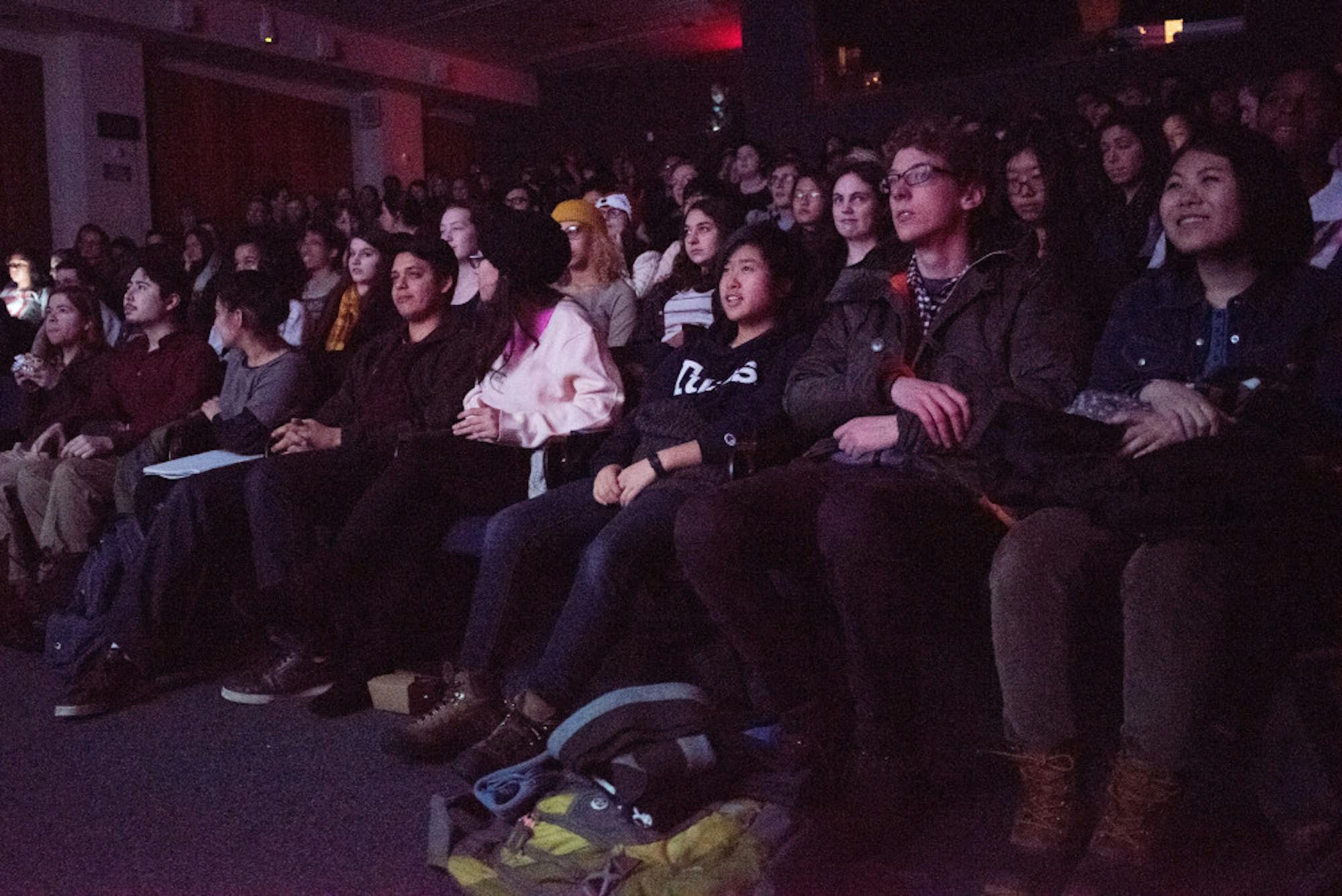Today, most believe film projectors are relics of a bygone era. The pace of technology and the difficulty of acquiring film means that, over the years, theaters have dropped the analog format one by one.
At Tufts, however, a group of students still works to preserve the “lost art” of projection. Instead of a DVD player, Tufts Film Series (TFS) uses a pair of aging 35mm film projectors for their screenings whenever they can get a film copy of a movie. Though the machines are finicky, trained and in-training TFS projectionists have been working in the booth with them for about three decades.
According to sophomore Dan Friedman, TFS’ co-chair, most of the group’s 40 members are trained or undergoing training to work the projector.
“We have about 40 people in the group, and I’d say 30-35 of them … are trained,” Friedman said. “That’s the big attraction, doing [film projection].”
Friedman said that TFS’ current projectors are the second generation that the group has owned.
“Currently we have two 35mm projectors, which we’ve had for 10-15 years; they’re big, big machines: the reels that we put on them are like a foot and a half to two feet in diameter, so it’s definitely difficult to fit those,” he said. “Before that, in the '80s, when our first projectors were installed, they were 16mm, but then we moved up to these really nice 35mm that just have better film quality.”
For TFS projectionists, learning the craft requires at least two training sessions with senior projectionists. These sessions include training on splicing film, which projectionists must learn before they are allowed to run a supervised screening by themselves, according to Friedman.
Sophomore MichaelaMellen is a TFS projectionist. She said that plenty can go wrong with a projector during a screening.
"There's ... missed changeovers ... sometimes I rewind film and it will just unspool and unravel," Mellen said.
Movies on film, especially if they're long, usually have to be divided into two or three reels, and mistakes are often made at the changeover the moment in a screening when a projectionist changes reels by switching to another pre-loaded projector. Changeovers have to be seamless so as not to break the audience's immersion.
"Sometimes we have to take 15-minute breaks in between reels if something goes catastrophically wrong," Mellen said. "We had a horrible showing of '[The Hunger Games:] Catching Fire' (2013) because we missed a changeover and had to fix that."
Even though working with film has its issues, Friedman says that movies shown in film still boast a marked advantage in picture quality over the digital format.
"There’s a very noticable difference between film and DVD -- the picture’s smaller on DVD, the colors aren’t as good," he said. "Whereas with film, it’s mostly that the picture’s better, bigger and brighter."
Along with the quality of the film itself, Friedman, as a projectionist, appreciates the physicality of working with 35mm.
"What we’re doing is the same thing that projectionists have been doing … for the past 50 years," he said. "You feel like you’re doing a trade when you’re doing it, there’s more of a connection when you’re a doing a movie when you’re doing it with film."
Mellen feels the same way.
"I just enjoy working with film because it's more ... hands-on," she said. "You can see each individual frame of a film, it's a lot more process than just popping in a DVD and pressing a button."
According to Mellen, TFS' commitment to film has helped them form a relationship with the independently-owned Somerville theater, which also uses 35mm film projectors.
"We're lucky that we’ve gotten to tour the Somerville theater," she said. "The head projectionists there are very committed and just try to preserve it, because it really is an art form. We do a scaled-down version of that at TFS, but there's so much more that can go into it."
As demand for film decreases, distributors can't always supply a film copy of their movies.
"We get our movies from our distributors ... there are distributors that distribute to movie theaters and there are distributors that distribute to colleges after those films have gone through the movie theater circuit," he said. "Distributors aren’t always going to have film, so 50 percent of the time ... they’ll send us digital, and that’s just inevitable, but the other 50 percent of the time we’re running film."
As a filmmaker, Tufts Drama Department professor Jennifer Burton believes that film and projector reels connect people to the medium, something that digital projectors cannot offer.
“I really appreciate the way that looking at a film reel ... emphasizes how a film is a medium that unfolds over time,” she said. “There is a certain aspect that you lose, that connection to the physical quality of the film, when you move to digital."
According to Burton, movies shot on film demand greater foresight and preparation.
“The thinking with shooting -- when you shoot on film, you have to make many choices before you shoot,” she said. “So there is a tremendous preparation work that goes in ... [a] tremendous amount of effort and energy that goes [into] choosing how to make a project. Whereas now, you have these tremendous materials, which can be very free but also can be a bit overwhelming both for viewers and filmmakers ... [who] have to deal with editing it."
She understands, however, that film and projection are rarely understood as art forms, as evidenced by the fact that today, the proper equipment is hardly available.
“I think what’s difficult is you don’t have the equipment anymore,” she said. “For years, even when we were still screening on film in the movie theaters, it was not valued as an art. It was really seen as a labor job that anyone can do ... so I really think we are not talking just [that] it was lost in the past few years; it has been something that has not been valued in the commercial field for a long time.”
Burton described projection as just one aspect of the unique experience of seeing a movie in theaters.
“I think the experience of seeing the beautiful print that’s being projected on the beautiful screen with good equipment is wonderful,” she said. “[Projection] is a skill you can learn, and it really has to do with all the other ingredients. You also have to have good prints, good equipment, a good screening room that is dark and an audience that is not texting and talking. And all these things contribute to a communal experience that is really unlike watching a film alone on a DVD.”
Burton agrees with Mellen and Friedman that the idea of projection as an art form comes from the interaction between film and projector, as well as the additional effort that goes into the operation.
“What you end up appreciating [is when] something ... is done on the print, people come with an expectation that is gonna be a heightened artistic experience; they are aware that it took more energy and effort to project that film for that audience,” she said. “So they come with a greater appreciation already. I think that would be the difference."






